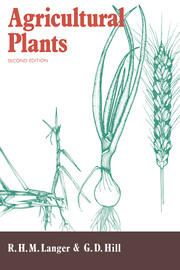Book contents
- Frontmatter
- Contents
- Preface to the first edition
- Preface to the second edition
- 1 World population and crop production
- 2 Plant structure
- 3 Liliaceae
- 4 Poaceae
- 5 Apiaceae
- 6 Asteraceae
- 7 Brassicaceae
- 8 Cannabinaceae
- 9 Chenopodiaceae
- 10 Cucurbitaceae
- 11 Fabaceae
- 12 Lamiaceae
- 13 Linaceae
- 14 Malvaceae
- 15 Papaveraceae
- 16 Solanaceae
- 17 Physiological basis of yield
- Index of specific names
- Subject index
8 - Cannabinaceae
Published online by Cambridge University Press: 05 June 2012
- Frontmatter
- Contents
- Preface to the first edition
- Preface to the second edition
- 1 World population and crop production
- 2 Plant structure
- 3 Liliaceae
- 4 Poaceae
- 5 Apiaceae
- 6 Asteraceae
- 7 Brassicaceae
- 8 Cannabinaceae
- 9 Chenopodiaceae
- 10 Cucurbitaceae
- 11 Fabaceae
- 12 Lamiaceae
- 13 Linaceae
- 14 Malvaceae
- 15 Papaveraceae
- 16 Solanaceae
- 17 Physiological basis of yield
- Index of specific names
- Subject index
Summary
This is a very small family comprising only two genera and three species. Of these, two are crop plants of economic importance, hop and hemp, while the third, the Japanese hop, is occasionally grown in gardens as a climbing ornamental. All have unisexual flowers and are dioecious.
HOP (HUMULUS LUPULUS)
The hop (Humulus lupulus) is a perennial plant with tall, climbing stems which need to be supported. The plant is grown for its female in-florescences which are used for the brewing of beer.
Origin and history of hop
There is some uncertainty concerning the origin of the hop but, since the Japanese hop and the related hemp both come from central Asia, it seems that Humulus is of Asian origin and that it spread to Europe and America from there. It appears that hops have been used in beer brewing for a very long time, probably for some 2000 years at least, according to an old Finnish saga, Kalevala. The crop was certainly well established in central Europe by the Middle Ages, especially what is now Czechoslovakia and Bavaria. Flemish planters in the sixteenth century brought it to England where it found ready acceptance in Kent. It was taken to North America by the early settlers and is now cultivated predominantly along the Pacific coast. Similarly, it was one of the crop plants transported to Australia and New Zealand when European settlement began there, and in fact was reported to grow in New South Wales as early as 1804.
- Type
- Chapter
- Information
- Agricultural Plants , pp. 190 - 196Publisher: Cambridge University PressPrint publication year: 1991

